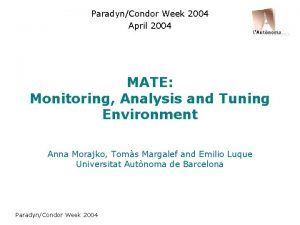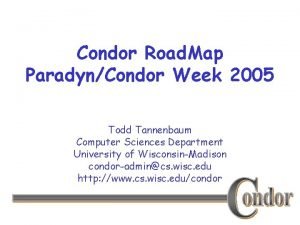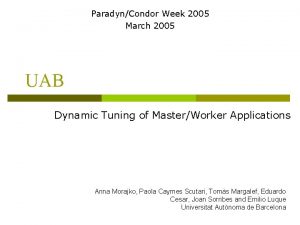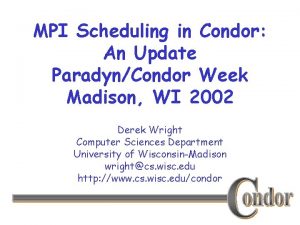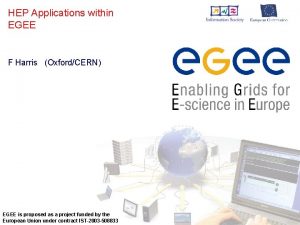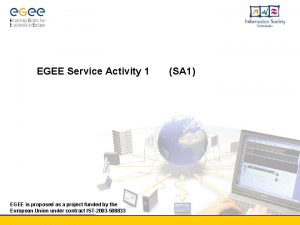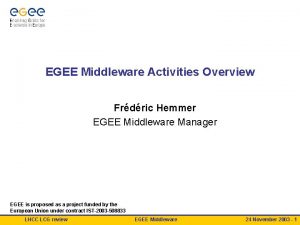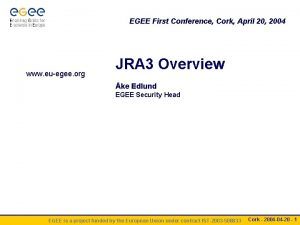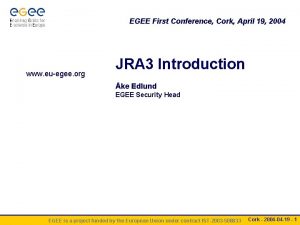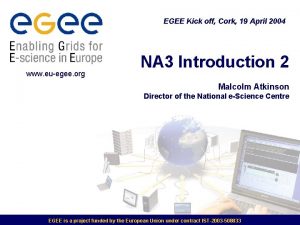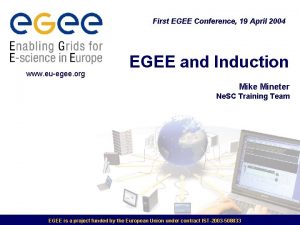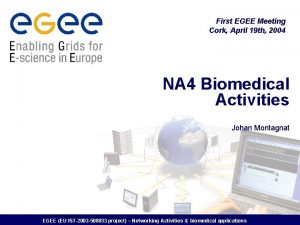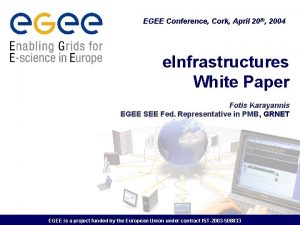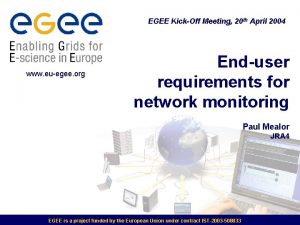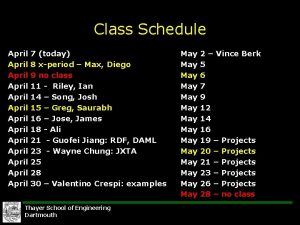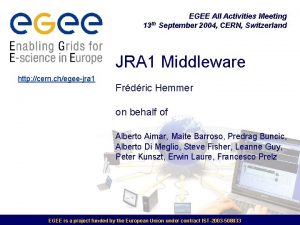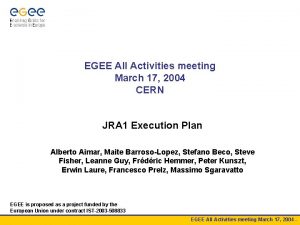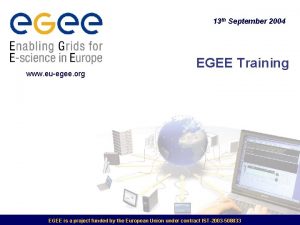ParadynCondor Week April 16 2004 The EGEE project

























- Slides: 25

Paradyn/Condor Week, April 16, 2004 The EGEE project: An overview Frédéric Hemmer EGEE Middleware Manager EGEE is a project funded by the European Union under contract IST-2003 -508833

Contents • • • EGEE - what is it and why is it needed? Grid operations – providing a stable service Grid middleware – current and future Networking activity Summary The material of this talk is the work of many people in EGEE and LCG Despite its name EGEE is an International project involving in particular Israel, Russia and US Paradyn/Condor Week, April 16, 2004 - 2

Background • Networking, commodity computing and distributed software tools became ripe for Grid technology to start become available at the end of the 1990’s • Many public funded projects (in the US and in the EU) launched since • Grid computing a key activity of the EU programmes • Industrial and commercial Grids have been following (see a good sample on the www. cern. ch/gridcafe portal and also www. gridstart. org) • Major IT vendors involved in Grid activity Paradyn/Condor Week, April 16, 2004 - 3

EGEE: Why? • Access to a production quality grid will change the way science and business is done • Current Grid R&D projects run to completion within the next few months or next year • The EGEE partners have already made major progress in aligning national and regional Grid R&D efforts, in preparation for EGEE • EGEE will preserve the current strong momentum of the European Grid community and the enthusiasm of the hundreds of young European researchers already involved in EU Grid projects (>150 in EU Data. Grid alone) Paradyn/Condor Week, April 16, 2004 - 4

EGEE Manifesto: Enabling Grids for E-science in Europe • Goal • Create a wide European Grid production quality infrastructure on top of present and future EU RN infrastructure Applications • Build On: • • EU and EU member states major investments in Grid Technology International connections (US and AP) Several pioneering prototype results Large Grid development teams in EU require major EU funding effort Grid infrastructure • Approach • • Leverage current and planned national and regional Grid programmes Work closely with relevant industrial Grid developers, NRENs and US-AP projects Geant network Paradyn/Condor Week, April 16, 2004 - 5

EGEE Partners • Leverage national resources in a more effective way for broader European benefit • 70 leading institutions in 27 countries, federated in regional Grids Paradyn/Condor Week, April 16, 2004 - 6

EGEE Project Structure 24% Joint Research 28% Networking JRA 1: Middleware Engineering and Integration JRA 2: Quality Assurance JRA 3: Security JRA 4: Network Services Development NA 1: Management NA 2: Dissemination and Outreach NA 3: User Training and Education NA 4: Application Identification and Support NA 5: Policy and International Cooperation 48% Services SA 1: Grid Operations, Support and Management SA 2: Network Resource Provision Emphasis in EGEE is on operating a production grid and supporting the endusers Paradyn/Condor Week, April 16, 2004 - 7

EGEE Applications • EGEE Scope : ALL-Inclusive for academic applications (open to industrial and socio-economic world as well) • The major success criterion of EGEE: how many satisfied users from how many different domains ? • 5000 users (3000 after year 2) from at least 5 disciplines • Two pilot applications selected to guide the implementation and certify the performance and functionality of the evolving infrastructure: Physics & Bioinformatics Application domains and timelines are for illustration only Paradyn/Condor Week, April 16, 2004 - 8

The pilot applications • High Energy Physics with LHC Computing Grid (www. cern. ch/lcg) relies on a Grid infrastructure to store and analyse petabytes (1015 bytes) of real and simulated data. LCG is a major source of resources, requirements and a hard deadlines with no conventional solution available • In Biomedics several communities are facing equally daunting challenges to cope with the flood of bioinformatics and healthcare data. Need to access large and distributed non-homogeneous data and important on-demand computing requirements Paradyn/Condor Week, April 16, 2004 - 9

EGEE Implementation • From day 1 (1 st April 2004) Production grid service based on the LCG infrastructure running LCG-2 grid middleware LCG-2 will be maintained until the new generation has proven itself (fallback solution) § VDT support for Condor/GT 2 based code is needed 1 H 05 at least • In parallel develop a “next generation” grid facility Produce a new set of grid services according to evolving standards (Web Services) Run a development service providing early access for evaluation purposes Will replace LCG-2 on production facility in 2005 LCG-1 LCG-2 Globus 2 based EGEE-1 EGEE-2 Web services based VDT EDG . . . Ali. En LCG . . . EGEE Paradyn/Condor Week, April 16, 2004 - 10

EGEE and LCG EGEE builds on the work of LCG to establish a grid operations service • LCG: a worldwide collaboration of • The LHC experiments • The Regional Computing Centres • Physics institutes • Mission: • Prepare and deploy the computing environment that will be used by the experiments to analyse the LHC data • Strategy: • Integrate thousands of computers at dozens of participating institutes worldwide into a global computing resource • Rely on software being developed in advanced grid technology projects, both in Europe and in the USA Paradyn/Condor Week, April 16, 2004 - 11

Grid operations • Create, operate, support and manage a production quality infrastructure • Offered services: • Middleware deployment and installation • Software and documentation repository • Grid monitoring and problem tracking • Bug reporting and knowledge database • VO services • Grid management services Paradyn/Condor Week, April 16, 2004 - 12

Operations Structure • Implement the objectives to provide • • Access to resources Operation of EGEE as a reliable service Deploy new middleware and resources Support resource providers and users • With a clear layered structure • • instances Operations Management Centre (CERN) § Overall grid operations coordination Core Infrastructure Centres § CERN, France, Italy, UK, Russia (from M 12) § Operate core grid services Regional Operations Centres § One in each federation, in some cases these are distributed centres § Provide front-line support to users and resource centres § Support new resource centres joining EGEE in the regions § Support deployment to the resource centres Resource Centres § Many in each federation of varying sizes and levels of service § Not funded by EGEE directly 1 5 ~11 50+ Paradyn/Condor Week, April 16, 2004 - 13

EGEE Computing Resources • Resource Centers foreseen in the project April 2004: 10 sites Region July 2005: 20 sites CPU nodes Disk (TB) CPU Nodes Disk (TB) CERN 900 140 1800 310 UK + Ireland 100 25 2200 300 France 400 15 895 50 Italy 553 60. 6 679 67. 2 North 200 20 2000 50 South West 250 10 Germany + Switzerland 100 2 400 67 South East 146 7 322 14 Central Europe 385 15 730 32 Russia 50 7 152 36 Totals 3084 302 8768 936 Paradyn/Condor Week, April 16, 2004 - 14

Deployment Status Core Sites already integrated With the other sites (currently running LCG-1), the expected capacity will exceed the previsions foreseen for 2004: around 4000 CPUs at about 30 sites Site CPU CERN 324 FZK 144 PIC 160 FNAL 4 CNAF 715 Nikhef 250 Taipei 98 RAL 146 Total 1841 Paradyn/Condor Week, April 16, 2004 - 15

Deployment Issues • Need to expand on existing LCG service while maintaining stability • • Add more sites/resources (some have no previous experience with grids) § Experience has shown that this can be effort consuming § Problematic sites have been causing problems for the whole system Introduce applications and VOs from non-HEP (Bio-medical) § Need to clarify processes and information flow • Portability • • Support for further platforms (currently just Red. Hat 7. 3) Middleware dependencies and packaging • Middleware Support • • Deterministic Support Model has been formalized Essential to have (so far excellent) VDT support for Condor/Globus • “ 24 x 7” operational support • • • Currently have GOC at RAL http: //goc. grid-support. ac. uk/ Being replicated at Taipei (and maybe Canada? ) Prototype accounting system (based on R-GMA) ready for the release in April 2004 (testing, documentation and packaging done) Paradyn/Condor Week, April 16, 2004 - 16

Expected Developments in 2004 • General: • • LCG-2 will be the service run in 2004 – aim to evolve incrementally Goal is to run a stable service • Some functional improvements: • • Extend access to MSS – tape systems, and managed disk pools Distributed vs replicated replica catalogs § To avoid reliance on single service instances • Operational improvements: • • • Monitoring systems – move towards proactive problem finding, ability to take sites on/offline; experiment monitoring Continual effort to improve reliability and robustness Develop accounting and reporting • Address integration issues: • • • With large clusters, with storage systems Ensure that large clusters can be accessed via grid Issue of integrating with other applications and non-LHC experiments New release foreseen end April 2004 Paradyn/Condor Week, April 16, 2004 - 17

EGEE Middleware Activity • Hardening and re-engineering of existing middleware functionality, leveraging the experience of partners • Activity concentrated in few major centers and organized in “Software clusters” • Key services: • • Data Management (CERN) Information Collection (UK) Resource Brokering, Accounting (Italy-Czech Republic) Quality Assurance (France) Grid Security (Northern Europe) Middleware Integration (CERN) Middleware Testing (CERN) Paradyn/Condor Week, April 16, 2004 - 18

Characteristics of the new middleware • Develop a lightweight stack of generic middleware useful to LHC experiments and Bio. Medicals based upon existing components • • Biomedical applications have important security requirements (e. g. confidentiality) that need to be addressed. Focus is on re-engineering and hardening Early prototype and fast feedback turnaround envisaged Use a service oriented approach A note on OGSI/WSRF/WS/…. • Still discussing – nothing has settled yet • Need to take a step back • • Focus on the service decomposition, semantics, interplay rather than the envelope WS seems to provide a useful abstraction • • Widely used in industry, Grid projects, Internet computing (Google, Amazon) Need to follow standardization efforts to be able to adopt them once settled Paradyn/Condor Week, April 16, 2004 - 19

Middleware approach • Formed a design team with members from • • • Break down the proposed architecture to real components Identify critical components (and what existing software to use for the first instance of a prototype) Define semantics and interfaces of these component Focus on key services discussed; exploit existing components Initially an ad-hoc installation at CERN and Wisconsin Aim to have first instance ready by end of April • • • all members will be part of EGEE as of April 1 st From US and Europe Started intense technical discussion to • • • Ali. En VDT EDG Open only to a small user community Expect frequent changes (also API changes) based on user feedback and integration of further services Enter a rapid feedback cycle • • Continue with the design of remaining services Enrich/harden existing services based on early user-feedback Paradyn/Condor Week, April 16, 2004 - 20

Initial Services • Data management • • Storage Element § SRM based; allow POSIX-like access Workload management • • Computing Element § Allow pull and push mode More discussions needed • • • Information and monitoring Security Guiding principles: • • Lightweight services § Easily and quickly deployable Interoperability § Allow for multiple implementations (medium/long term) – Being based on WS should help • • Co-existence with deployed infrastructure § Run as an application Security: • • Need to integrate components with quite different security models Start with a minimalist approach based on VOMS and my. Proxy Paradyn/Condor Week, April 16, 2004 - 21

Condor Team contributions to EGEE Middleware • Many years of experience in designing and running real world distributed systems • • Essential for relatively new Grid Middleware technologies Many of the problems we see today are related to robustness, deployment, scalability • Proven scheduling technologies • Condor/Condor-G • Leadership in the new Middleware Design Group • • Monthly face-to-face meetings covering all essential parts of Middleware Miron Livny’s influence and contributions are essential • Support of Middleware Components for the existing LCG-2 code base (VDT) • • Condor, Globus GT 2 leveraging the NSF Middleware Initiative Proactive, bilateral problem resolution and enhancements • US contribution to EGEE project • Essential, as many applications are/will be worldwide, not only European Paradyn/Condor Week, April 16, 2004 - 23

EGEE Networking Activity • Dissemination and outreach • Lead by TERENA • User training and induction • • Lead by Unv Edin. (Ne. SC) The success of EGEE is measured by the impact it has on collaborative European science The goal is to support communities of users Therefore induction and training have a high priority from the outset • Application identification and support • • Two pilot application centers (for high energy physics and biomedical grids) One more generic component dealing with longer term recruitment and support of other communities • Policy and International cooperation • • Establish Grid policy forum Coordinate relations with other projects (EU and beyond) • Training courses (based on EDG tutorials) will be available from July 2004 • Grid school near Naples, Italy 18 -30 July 2004: http: //www. dma. unina. it/~murli/Grid. Summer. School 2004/ Paradyn/Condor Week, April 16, 2004 - 24

Summary • EGEE is expected to deliver a production Grid infrastructure for scientific applications • The project just started weeks ago • • We have a running grid service based on LCG-2 All EGEE activities are well advanced and ready to go • Biomedical and physics are the pilot applications domains that will lead the exploitation of the EGEE Grid infrastructure • US contribution essential through support of existing middleware and design of new generation middleware • The first project conference will be held in Cork (Ireland) 18 -22 nd April http: //public. eu-egee. org/kickoff/index. html Paradyn/Condor Week, April 16, 2004 - 25

Further Information To know more: EGEE – www. eu-egee. org Paradyn/Condor Week, April 16, 2004 - 26
 Omega kreasi bersama
Omega kreasi bersama Egee 102 home activity 4
Egee 102 home activity 4 Egee rhone alpes
Egee rhone alpes Apod nasa gov calendar 1982
Apod nasa gov calendar 1982 Tbss tornado
Tbss tornado Week by week plans for documenting children's development
Week by week plans for documenting children's development April art project
April art project Project 6 week 5
Project 6 week 5 Hình ảnh bộ gõ cơ thể búng tay
Hình ảnh bộ gõ cơ thể búng tay Frameset trong html5
Frameset trong html5 Bổ thể
Bổ thể Tỉ lệ cơ thể trẻ em
Tỉ lệ cơ thể trẻ em Chó sói
Chó sói Chụp tư thế worms-breton
Chụp tư thế worms-breton Alleluia hat len nguoi oi
Alleluia hat len nguoi oi Môn thể thao bắt đầu bằng chữ f
Môn thể thao bắt đầu bằng chữ f Thế nào là hệ số cao nhất
Thế nào là hệ số cao nhất Các châu lục và đại dương trên thế giới
Các châu lục và đại dương trên thế giới Công thức tiính động năng
Công thức tiính động năng Trời xanh đây là của chúng ta thể thơ
Trời xanh đây là của chúng ta thể thơ Mật thư anh em như thể tay chân
Mật thư anh em như thể tay chân Làm thế nào để 102-1=99
Làm thế nào để 102-1=99 Phản ứng thế ankan
Phản ứng thế ankan Các châu lục và đại dương trên thế giới
Các châu lục và đại dương trên thế giới Thơ thất ngôn tứ tuyệt đường luật
Thơ thất ngôn tứ tuyệt đường luật Quá trình desamine hóa có thể tạo ra
Quá trình desamine hóa có thể tạo ra


























